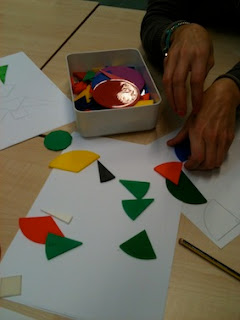Although I’ve blogged before about right angles, one summer term I had the rare opportunity to work on a series of activities, both indoors and outside to introduce the concept with one class. I thought I’d just blog about the mix of indoor and outdoor activities which happened because I feel that this blog sometimes offers a lop-sided view on both learning and what I do.
Since 2007, I was never employed to be an “outdoor learning” teacher. In one school my job was to cover Additional Support Needs (ASN) classes whilst the teacher had their non-contact time. However I made the person decision, with the support of the head teacher to work almost always outside. I liked being able to adapt work so that being outside provides a new angle on a standard teaching activity.
Session 1
We began by exploring 2D shapes which we found in a box and tried to remember the names of each one. Then we went outside and the challenge was to create as many shapes within shapes as possible using just 6 large and 6 small sticks. I needed this, simply so that I could find out what the children already knew and their levels of interest and understanding that existed.

Session 2
The concept of right angles was revised. We looked at how when two straight lines or segments meet, this creates an angle. A right angle has 90 degrees. Right angle detectors were issued and the children were shown how to use them to find right angles. We began in the classroom, looking around for different right angles. Then we went outside and continued the search…
Consistently we found far more angles than we originally estimated…

It was probably harder to find other angles. Thankfully the playground markings were a good topic of conversation around this…

Back inside we played “Hunt the Shape”. This involved taking turns to hide shapes around the classroom for others to find. The children had to identify any right angles in the shapes which they found.
Session 3
The challenge in this session was to see if right angles existed in nature. I was fairly certain that this would not be the situation. But as with so many activities, the children proved me wrong. A more advanced lesson on this theme can be found in this blog post.
One of the challenges is deciding whether sticks like the one in the above photo are truly a right angle… ouch! It was definitely easier to determine when a broken branch was discovered…
The children were incredibly observant and found examples in different places…
Session 4
This time we went back to creating shapes with 6 large and 6 small sticks to make as many right angles as possible. The children were their usual creative selves. For example, most children tend to stick to rectangles and squares. Yet, look at this nice illustration of the potential of triangles…

Part of the fun is counting the angles – having a spare stick is helpful to do this…

After this, we followed up with a simple drawing activity to check we could identify right angles when presented on paper. I decided that the children would prefer this activity to a worksheet check-up and certainly the children readily completed this activity.

Some just drew shapes whilst others went for creating a picture from the shapes. Both had to note the angles in each shape.

The children enjoyed the freedom and creativity that the activities permitted and for me, I was able to gauge where to go from week to week as it was straightforward to see who was grasping the concepts and who needed more support. It’s important to build up children’s confidence to undertake maths and engage positively in dialogue that develops their understanding. It will be interesting to see how much they remember next session.




















I love this. Teaching maths in a kinaesthetic way can be so beneficial for the kids who might not see the real life application of maths in a classroom. My sister is doing her dissertation on different styles of learning in maths and i’ll be sure to forward this on to her.
http://www.smudge-dribble.com
I love this. Teaching maths is such a kinaesthetic way can really help kids who can’t see the real life applications of maths. My sister is doing her dissertation on how effective different styles of learning are so I shall be sure to link her to your blog.
http://www.smudge-dribble.com
Fantastic Juliet, I bet the children love to see you coming in an sub teacher! Going to keep this one for my primary collagues in September to try & entice them outside!!
I absolutely love what you are doing here for the kids. You’re making learning so much fun for the kids just like Ms. Frizzle from the Magic School Bus only without the magical latter. Keep it up!
sweetcounter.co.uk
It is all very doable. I’ve always had a practical approach to shape work so I think that’s why it slides outside so nicely!
It really fun to teach pupils this way. For the first time I understand how i can engage kinaesthetic learners in Math classroom.